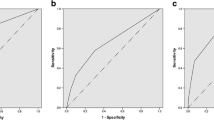Abstract
We used a self-report questionnaire to identify outpatients with chronic symptoms of sleep disorders and/or high pretest probability for sleep apnea as well as for restless legs syndrome (RLS), insomnia, and narcolepsy. Surveys were presented to patients waiting for an appointment in Veterans Administration (VA) Medical Center clinics in Northeast Ohio, USA. Items addressed the frequency of snoring behavior; wake time sleepiness or fatigue and history of obesity/hypertension for high risk for sleep apnea (Netzer et al. 1999), along with other symptoms, were scored as positive vs negative risk for insomnia, narcolepsy, and RLS. Of the patients offered the surveys, 886 (59.2%) provided timely responses to the questionnaire. Mean age was 62.5 years (range, 19 to 85 years); 95% were males; mean body mass index was 29.3 kg/cm2 (range, 15.1 to 57.5 kg/cm2); and mean Epworth Sleepiness Scale score was 8.3 (range, 1 to 22) with 4.6% having a score >17. Of the respondents, 47.4% met high-risk criteria for sleep apnea, 41.7% for insomnia, 19% for restless leg syndrome, and 4.7% for narcolepsy. Twenty-four percent reported use of sleeping pills or bedtime alcohol. Drowsy driving >3–4 days a week or every day was reported in 5.7%. VA primary care patients have high prevalence for pretest probability for sleep apnea. This population also reports chronic symptoms for other sleep disorders and for drowsy driving.




Similar content being viewed by others
References
Kapur VK, Redline S, Nieto FJ, Young TB, Newman AB, Henderson JA (2002) The relationship between chronically disrupted sleep and healthcare use. Sleep 25(3):289–296
Netzer NC, Hoegel JJ, Loube D et al (2003) Prevalence of symptoms and risk of sleep apnea in primary care. Chest 124(4):1406–1414
Lyznicki JM, Doege TC, Davis RM, Williams MA (1998) Sleepiness, driving, and motor vehicle crashes. Council on Scientific Affairs, American Medical Association. JAMA 279(23):1908–1913
Connor J, Whitlock G, Norton R, Jackson R (2001) The role of driver sleepiness in car crashes: a systematic review of epidemiological studies. Accident Anal Prev 33(1):31–41
Vgontzas AN, Kales A (1999) Sleep and its disorders. Annu Rev Med 50:387–400
Newman AB, Spiekerman CF, Enright P et al (2000) Daytime sleepiness predicts mortality and cardiovascular disease in older adults. The Cardiovascular Health Study Research Group. J Am Geriatr Soc 48(2):115–123
National Center on Sleep Disorders Research Working Group (1999) Recognizing problem sleepiness in your patients. Am Fam Phys 59(4):937–944
Ashton CM, Petersen NJ, Souchek J et al (1999) Rates of health services utilization and survival in patients with heart failure in the Department of Veterans Affairs medical care system. Am J Med Qual 14(1):55–63
Meissner HH, Riemer A, Santiago SM, Stein M, Goldman MD, Williams AJ (1998) Failure of physician documentation of sleep complaints in hospitalized patients. West J Med 169(3):146–149
Edis TE, Rosenberg L, Hudnell G, Jones L (1984) Sleep disorders among psychiatric outpatients. South Med J 77(9):1107–1108
Seftel AD, Strohl KP, Loye TL, Bayard D, Kress J, Netzer NC (2002) Erectile dysfunction and symptoms of sleep disorders. Sleep 25(6):643–647
Netzer NC, Stoohs RA, Netzer CM, Clark K, Strohl KP (1999) Using the Berlin Questionnaire to identify patients at risk for the sleep apnea syndrome. Ann Intern Med 131(7):485–491
Johns MW (1991) A new method for measuring daytime sleepiness: the Epworth Sleepiness Scale. Sleep 14(6):540–545
Miletin MS, Hanly PJ (2003) Measurement properties of the Epworth sleepiness scale. Sleep Med 4(3):195–199
Ohayon MM, Roth T (2002) Prevalence of restless legs syndrome and periodic limb movement disorder in the general population. J Psychosom Res 53(1):547–554
Ohayon MM, Roth T (2001) What are the contributing factors for insomnia in the general population? J Psychosom Res 51(6):745–755
Masa JF, Rubio M, Findley LJ (2000) Habitually sleepy drivers have a high frequency of automobile crashes associated with respiratory disorders during sleep. Am J Respir Crit Care Med 162(4 Pt 1):1407–1412
Connor J, Norton R, Ameratunga S et al (2002) Driver sleepiness and risk of serious injury to car occupants: population based case control study. BMJ 324(7346):1125
Stutts JC, Wilkins JW, Scott Osberg J, Vaughn BV (2003) Driver risk factors for sleep-related crashes. Accident Anal Prev 35(3):321–331
Cummings P, Koepsell TD, Moffat JM, Rivara FP (2001) Drowsiness, counter-measures to drowsiness, and the risk of a motor vehicle crash. Inj Prev 7(3):194–199
Chervin RD, Aldrich MS, Pickett R, Guilleminault C (1997) Comparison of the results of the Epworth Sleepiness Scale and the Multiple Sleep Latency Test. J Psychosom Res 42(2):145–155
Benbadis SR, Mascha E, Perry MC, Wolgamuth BR, Smolley LA, Dinner DS (1999) Association between the Epworth sleepiness scale and the Multiple Sleep Latency Test in a clinical population. Ann Intern Med 130(4 Pt 1):289–292
Acknowledgements
The authors thank the people participating in this study. Jamie Blecher and Jonathan Watkins provided assistance in the collection of questionnaires and the assessment of patients. Dr. Karem Principe-Rodriguez provided advice and counsel. This work was supported in part by the Department of Veterans Affairs Research Service, a Sleep Academic Award (KPS-KO7 HL03650), and the Division of Pulmonary and Critical Care Medicine, University Hospitals of Cleveland. The Cleveland Sleep Habits Questionnaire is held in copyright by iONSLEEP LLC (Shaker Heights, OH) and is available for academic or investigational use at no cost.
Author information
Authors and Affiliations
Corresponding author
Rights and permissions
About this article
Cite this article
Mustafa, M., Erokwu, N., Ebose, I. et al. Sleep problems and the risk for sleep disorders in an outpatient veteran population. Sleep Breath 9, 57–63 (2005). https://doi.org/10.1007/s11325-005-0016-z
Published:
Issue Date:
DOI: https://doi.org/10.1007/s11325-005-0016-z




